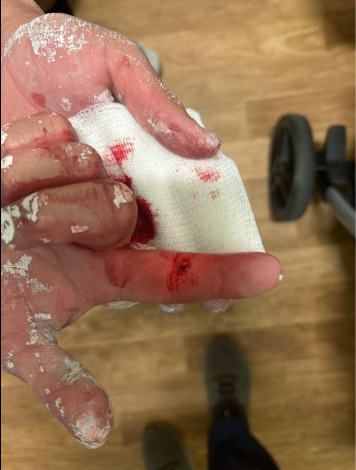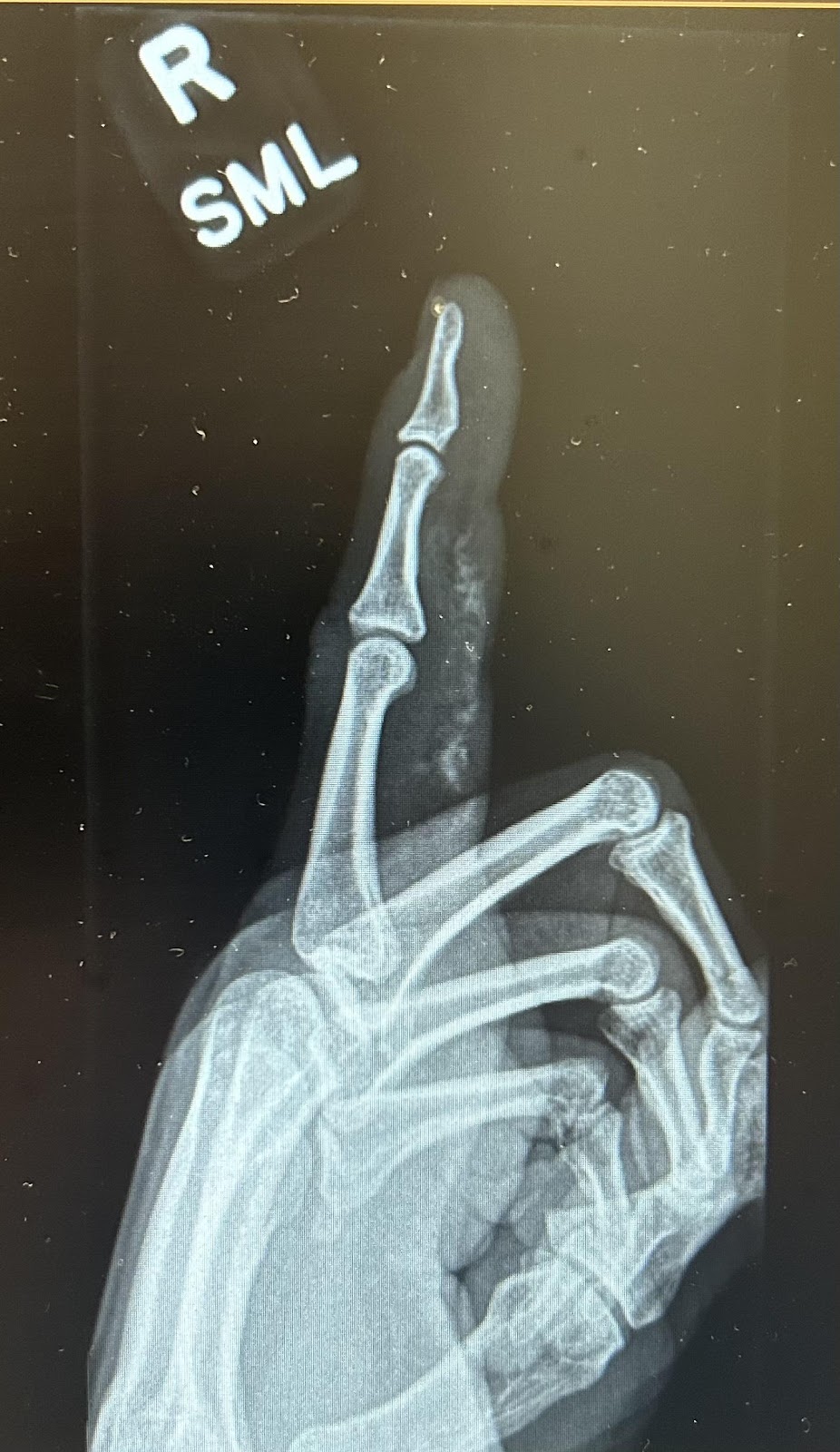Higher the Pressure Higher the Stakes
Author: Jonathan P. Coss, MD
Peer-Reviewer: Mark Hopkins, MD, CAQ-SM
Final Editor: Will Denq, MD, CAQ-SM
A 37-year-old male presents after accidentally shooting a high pressure paint gun into his right index finger at work. The paint was water based. He denies pain, there is no swelling, and he has full range of motion without pain at arrival to the ED.

Image 1. Picture of the injured right index finger. Image courtesy of Mark Hopkins, MD, CAQ-SM
What is the diagnosis?
High-Pressure Injection Injury of the right index finger
-
Pearl: Despite the benign appearance, this is a surgical emergency as amputation rates are between 30% and 48% [1].
-
Pearl: An important factor is the type of injected material. The rate of finger amputation after injection with oil-based paint is much higher than water based or air [6].
What is the mechanism of injury?
High-pressure injection injuries of the hand occur when the hand (usually non-dominant [9]) encounters the nozzle of a high-pressure injecting system such as a paint gun or air compressor [3]. Thousands of pounds of pressure can be transmitted causing limb threatening consequences.
This involves three phases [3]:
-
Direct mechanical impact of injection 🡪 pressure-induced neurovascular compromise, edema, and possible compartment syndrome as the pressure tears ligaments, tendons, neurovascular structures, and even osseous lesions. The injected material or air rapidly flows around the neurovascular bundle, following the path of least resistance. The injection can reach as proximally as the mediastinum.
-
Inflammatory sequelae and chemical interaction with biological substrates can lead to cytotoxic effects on tissues.
-
Microbial infection due to direct bacterial inoculation which can intensify necrosis precipitated by the first two phases.
What physical exam findings are expected?
Deceivingly, the patient will initially appear to have a benign, localized puncture wound. They will begin to complain of swelling, pain with a notable small puncture wound on exam. Digit will become edematous, pale and severely tender to palpation. Unfortunately, most patients see several different physicians with an average of 9 hours before obtaining the correct diagnosis, leading to the above noted sequela [10]. Additionally, the zone of injury can extend subcutaneously from the tip of the finger to the mediastinum and have catastrophic effects on the affected extremity.
Which imaging modalities can be used?
In the ED, multiple imaging studies can be utilized. Plain radiographs of the injured site will show the extent of penetration if the substance is radiopaque. Radiolucent material will not be visible but can appear as subcutaneous emphysema. CT or MRI can better assess soft tissue damage but usually are not necessary.

Image 2. Plain lateral radiograph of the right hand. Image courtesy of Mark Hopkins, MD, CAQ-SM
What is the management in the ED?
Prophylactic antibiotics such as a third-generation cephalosporin should be given with tetanus vaccine as needed [4,5]. Elevation of the limb after copious irrigation to remove large debris is recommended with the wound left open to drain. Avoid compression, icing, closing the wound or performing nerve blocks as these will reduce blood flow. Assess how proximal the injury extends. Serial examinations involving range of motion, skin discoloration, pulses, and a neurologic examination are prudent.
Transfer to a trauma center and emergent orthopedic/hand consultation is indicated for early surgical debridement to control the inflammatory response, decompress the compartments, and reduce the risk of long-term morbidity [8]. Repeat debridements are sometimes necessary within 48 to 72 hours increments until achieving the removal of all devitalized tissue and injected material.
When do you consult Orthopedics?
Orthopedics/hand surgery should be consulted emergently as there is an increased rate of amputation >10 hours to the OR, and higher rates with organic solvents if initial debridement took place >6 hours [3].
Case Update: For this patient, the surgical provider considered observation but due to concern for progression took the patient to the operating room. The patient was noted to have extensive spread of the white paint throughout the finger, primarily in the fat layer as well as very adherent to the dermis. Some of the paint traveled along the ulnar neurovascular bundle but dissection showed the bundle to be intact. There did not appear to be any significant extension of the paint proximal to the proximal digital flexion crease and the fat in the palm appeared clean. Additionally, the paint did not appear to have violated the flexor tendon sheath. He was discharged home after the initial washout.
References
[1] Bean B, Cook S, Loeffler BJ, Gaston RG. High-pressure water injection injuries of the hand may not be trivial Orthopedics. 2018;41:e245–51
[2] Couzens G, Burke FD. Veterinary high pressure injection injuries with inoculations for larger animals. J Hand Surg Br. 1995 Aug;20(4):497-9. [PubMed]
[3] Hadeed A, Anthony JH, Hoffler CE. Hand High Pressure Injury. [Updated 2023 Jun 26]. In: StatPearls [Internet]. Treasure Island (FL): StatPearls Publishing; 2024 Jan-. Available from: https://www.ncbi.nlm.nih.gov/books/NBK542210/
[4] Hogan CJ, Ruland RT. High-pressure injection injuries to the upper extremity: a review of the literature. J Orthop Trauma. 2006 Jul;20(7):503-11. [PubMed]
[5] Mirzayan R, Schnall SB, Chon JH, Holtom PD, Patzakis MJ, Stevanovic MV. Culture results and amputation rates in high-pressure paint gun injuries of the hand. Orthopedics. 2001 Jun;24(6):587-9. [PubMed]
[6] Rimmer MG, King JB, Franklin A. Accidental injection of white spirit into the hand in golfers. J Hand Surg Br. 1993 Oct;18(5):654-5. [PubMed]
[7] Rosenwasser MP, Wei DH. High-pressure injection injuries to the hand. J Am Acad Orthop Surg. 2014 Jan;22(1):38-45. [PubMed]
[8] Stark HH, Ashworth CR, Boyes JH. Paint-gun injuries of the hand. J Bone Joint Surg Am. 1967 Jun;49(4):637-47. [PubMed]
[9] Sirio CA, Smith JS, Graham WP. High-pressure injection injuries of the hand. A review. Am Surg. 1989 Dec;55(12):714-8. [PubMed]
[10] Wieder A, Lapid O, Plakht Y, Sagi A. Long-term follow-up of high-pressure injection injuries to the hand. Plast Reconstr Surg. 2006 Jan;117(1):186-9. [PubMed]


